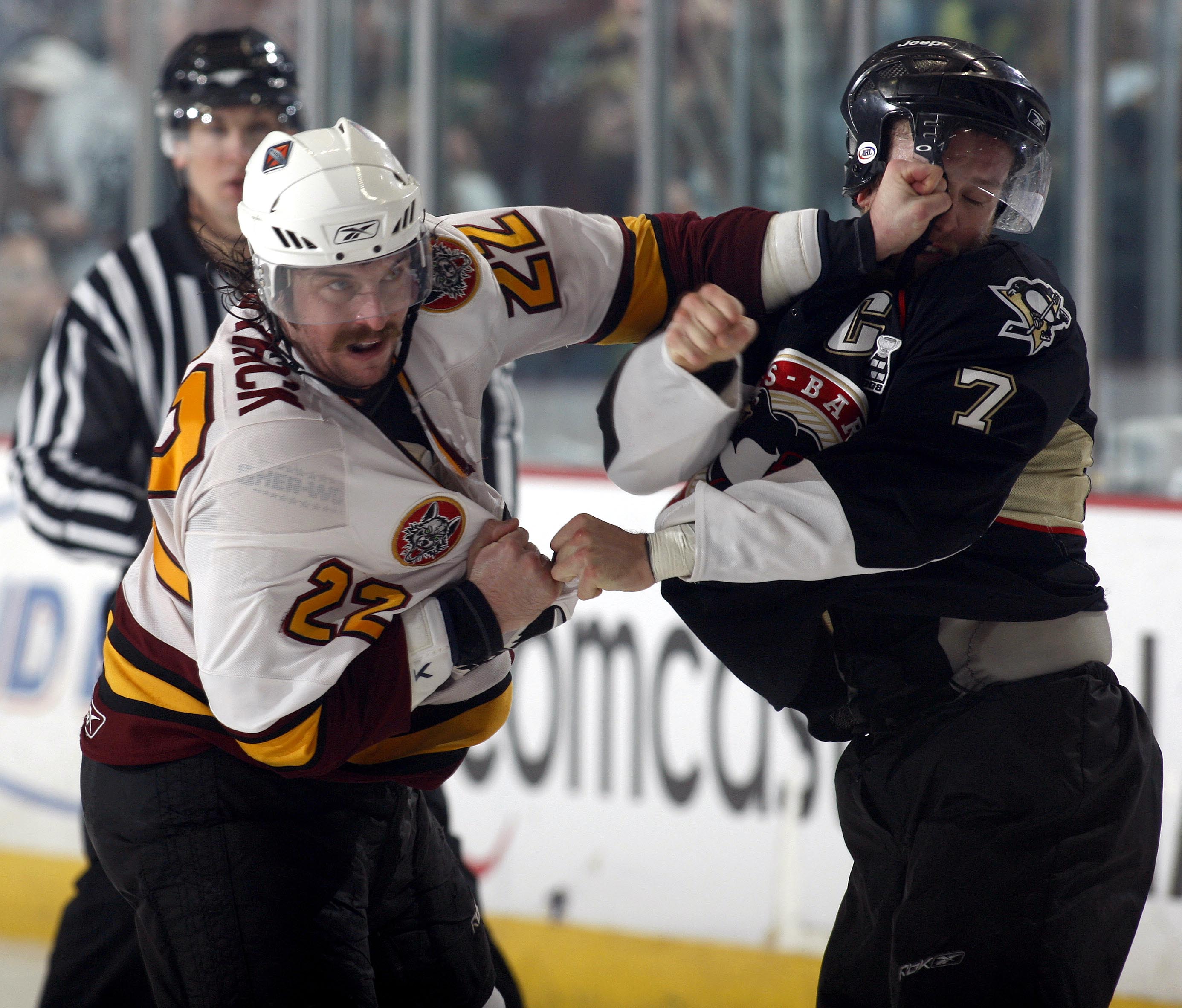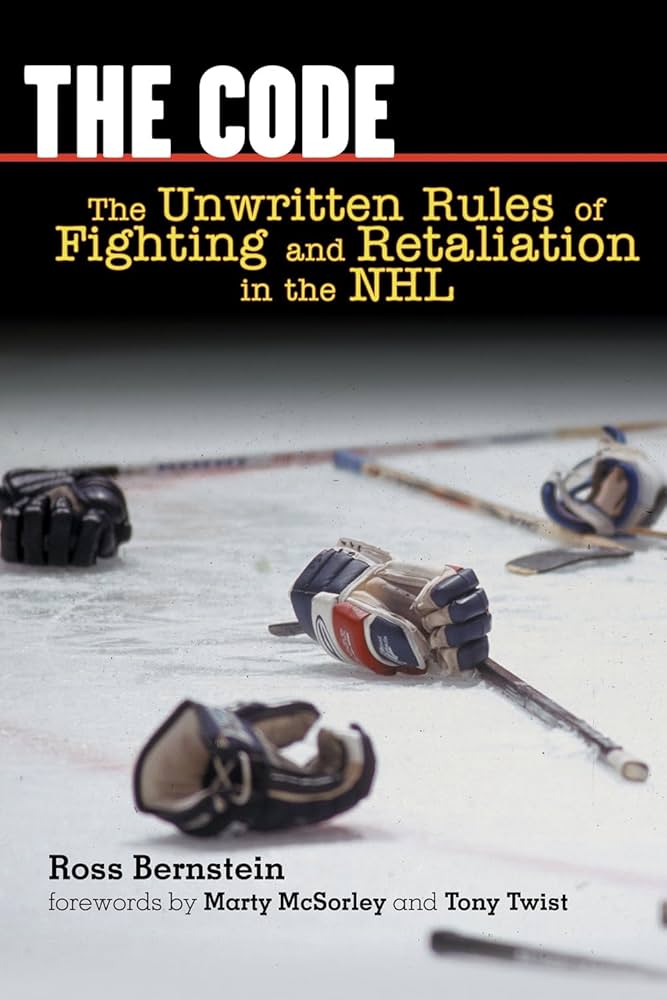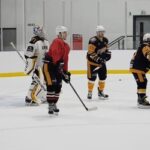Fighting in the NHL results in a five-minute major penalty for the involved players. Instigators can receive additional penalties.
Hockey fighting rules in the NHL have evolved to balance player safety and the sport’s physical nature. The primary rule enforces a five-minute major penalty for fighting, aiming to deter unnecessary aggression. Players who instigate fights can face extra penalties, such as a two-minute minor or a game misconduct.
These rules intend to maintain the sport’s integrity while protecting players. Enforcing these penalties helps reduce the frequency of fights and promotes a safer, more disciplined game. Understanding these rules is crucial for fans and players alike, ensuring everyone appreciates the sport’s regulations and the emphasis on safety.

Credit: en.wikipedia.org
Introduction To Hockey Fighting
Hockey fighting in the NHL follows specific rules to maintain player safety and game integrity. Players must drop their gloves and fight fairly, with referees closely monitoring the altercations. Penalties are imposed based on the severity and conduct during the fight.
Brief History
Hockey fighting has been a part of the NHL since its early days.
It gained popularity as a way to protect star players.
Players were allowed to fight without facing severe penalties.
Role In The Game
Hockey fighting is seen as a way to enforce unwritten rules.
It can change the momentum of a game quickly.
Players engage in fights to defend their teammates.
The Code Of Conduct
Hockey fighting in the NHL follows a unique set of rules. These rules are not official but respected by players. This unwritten code ensures fair and respectful fights.
Unwritten Rules
The unwritten rules of hockey fights include several key points:
- Consent: Both players must agree to fight.
- Equal Strength: Players should be of similar size and strength.
- No Cheap Shots: No hitting when the opponent is down.
- Remove Helmets: Helmets should be removed before the fight starts.
These rules help maintain the integrity of the game. They also ensure the safety of players.
Respect Among Players
Respect is crucial in hockey fights. Players show respect by following the code. They also ensure their opponents are not seriously injured. Here are some ways players show respect:
- Ending the Fight: Stop fighting if the opponent is hurt.
- Helping Up: Help the opponent up after the fight.
- Apologizing: Apologize if the fight was too rough.
Respect among players keeps the sport honorable. It also fosters a sense of camaraderie on the ice.
Penalties And Consequences
Hockey fights are part of NHL’s gritty charm. But, fights come with rules. The NHL enforces these rules through penalties and consequences.
Minor Penalties
Minor penalties are lighter punishments. They often involve less severe actions during a fight. Players can receive two-minute penalties. These are called “minor penalties.”
- Instigating a fight: A player who starts a fight gets two minutes.
- Unsportsmanlike conduct: Acts that disrespect the game get two minutes.
- Roughing: Small skirmishes lead to two-minute penalties.
Players sent to the penalty box serve their time. Their team plays short-handed during this period.
Major Penalties
Major penalties are more severe. They usually involve serious actions during a fight.
- Fighting: Engaging in a fight earns a five-minute penalty.
- Attempt to injure: Trying to hurt another player results in a match penalty.
- Third-man in: Joining a fight already in progress leads to a game misconduct.
Players serving major penalties spend more time in the penalty box. Their team endures longer short-handed periods.
| Penalty Type | Duration | Examples |
|---|---|---|
| Minor | 2 minutes | Instigating, Roughing |
| Major | 5 minutes | Fighting, Attempt to injure |
Understanding these penalties helps fans follow the game better. It also ensures players know the consequences of their actions on ice.

Credit: m.youtube.com
Role Of The Referee
The referee plays a crucial role during hockey fights. They ensure player safety and maintain game order. Referees have specific duties during fights. Their actions impact the game’s flow and fairness.
Breaking Up Fights
Referees must quickly break up fights. They aim to separate players safely. Referees use their bodies and whistles to intervene. They prevent further aggression and potential injuries.
Referees often work in pairs. One referee grabs each player. This technique helps manage the situation effectively. Referees communicate with players to calm them down.
Issuing Penalties
After breaking up a fight, referees issue penalties. They decide the appropriate punishment based on the fight’s severity.
| Penalty Type | Description | Duration |
|---|---|---|
| Minor Penalty | Less severe infractions | 2 minutes |
| Major Penalty | More severe infractions | 5 minutes |
| Misconduct Penalty | Extreme behavior | 10 minutes |
Referees ensure the penalties are fair. They communicate decisions to players and coaches. This maintains game integrity and fairness.
Instigator Rule
The NHL has specific rules for fights. One important rule is the Instigator Rule. This rule helps control fights and maintain game safety.
Definition
The Instigator Rule targets players who start fights. A player is an instigator if they clearly cause the fight. This means they throw the first punch or challenge another player.
Implications
Being an instigator leads to extra penalties. Players receive a minor penalty, a major penalty, and a ten-minute misconduct. These penalties add to the regular fighting penalty.
| Penalty Type | Duration |
|---|---|
| Minor Penalty | 2 minutes |
| Major Penalty | 5 minutes |
| Misconduct | 10 minutes |
- Minor Penalty: 2 minutes
- Major Penalty: 5 minutes
- Misconduct: 10 minutes
Coaches must also be careful. If a player instigates a fight in the last five minutes, the coach gets a fine. The fine can be up to $10,000.
The rule helps keep the game fair and safe. It discourages players from starting fights.
Role Of Enforcers
The role of enforcers in the NHL remains crucial despite changes in the game. Enforcers are players who protect teammates and keep the game clean.
Job Description
Enforcers have a specific job on the ice. Their main tasks include:
- Protecting star players from aggressive opponents
- Intimidating opposing players to prevent rough play
- Engaging in fights to boost team morale
They are not always the best scorers. Their strength lies in their physical presence and willingness to fight.
Impact On Team Dynamics
Having an enforcer changes the team dynamics significantly. Here are some key impacts:
| Aspect | Impact |
|---|---|
| Morale | Boosts team confidence knowing someone has their back |
| Safety | Reduces dangerous play from opponents |
| Psychological Edge | Creates fear in the opposing team |
Enforcers also play a vital role during playoffs. Their presence can intimidate opponents and shift game momentum.
Safety Measures
Hockey fights are common in the NHL. Safety is a top priority. The league has rules to ensure player safety during fights.
Protective Gear
Players wear protective gear to stay safe during fights. Helmets, gloves, and padding protect vital areas. Helmets shield the head from blows. Gloves protect hands and wrists. Padding guards the chest and shoulders.
| Protective Gear | Purpose |
|---|---|
| Helmet | Protects head |
| Gloves | Shields hands and wrists |
| Padding | Guards chest and shoulders |
Medical Protocols
Medical protocols are in place to handle injuries. Trainers and doctors are always present. They provide immediate care.
- Trainers respond quickly to injuries.
- Doctors assess serious conditions.
- Players receive treatment on the spot.
There are also concussion protocols. Players are evaluated for head injuries. Concussion tests ensure player safety.
- Initial assessment on the ice.
- Further tests in the locker room.
- Monitoring for symptoms after the game.
These safety measures protect players during fights. The NHL prioritizes player health and safety.
Changing Attitudes
Public Perception
Hockey fighting rules in the NHL have sparked mixed reactions.
Some see it as an essential part of the game, while others question its place in a modern, safety-conscious society.
Future Of Fighting In Hockey
The debate around fighting in hockey continues to evolve.
As the league prioritizes player safety, the future of fighting remains uncertain.

Credit: www.nytimes.com
Conclusion
Understanding the NHL’s hockey fighting rules helps fans appreciate the game better. These rules ensure player safety and maintain order. Knowing them can enhance your viewing experience. Stay informed and enjoy the thrilling sport responsibly. Keep following for more insights into the world of hockey.


